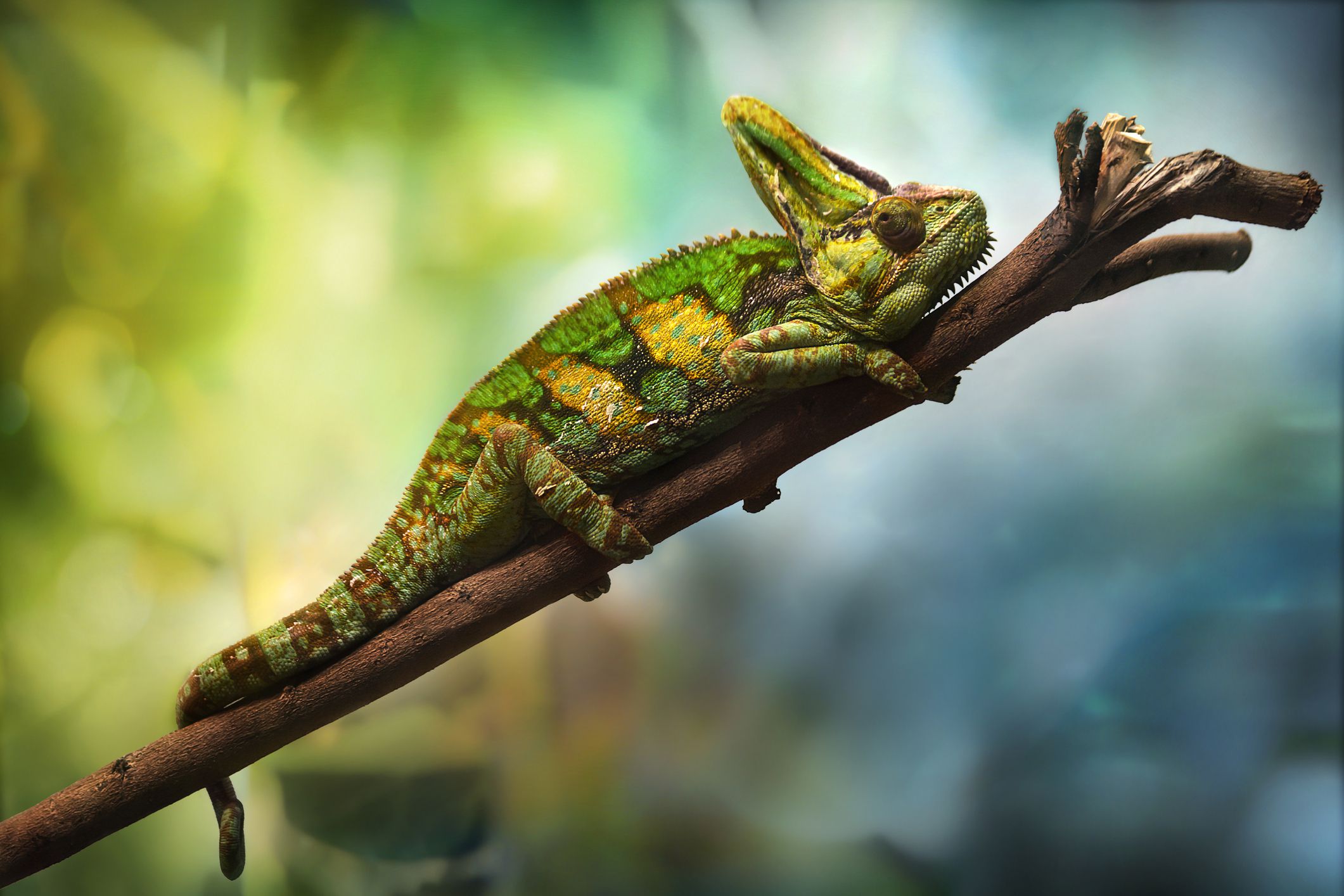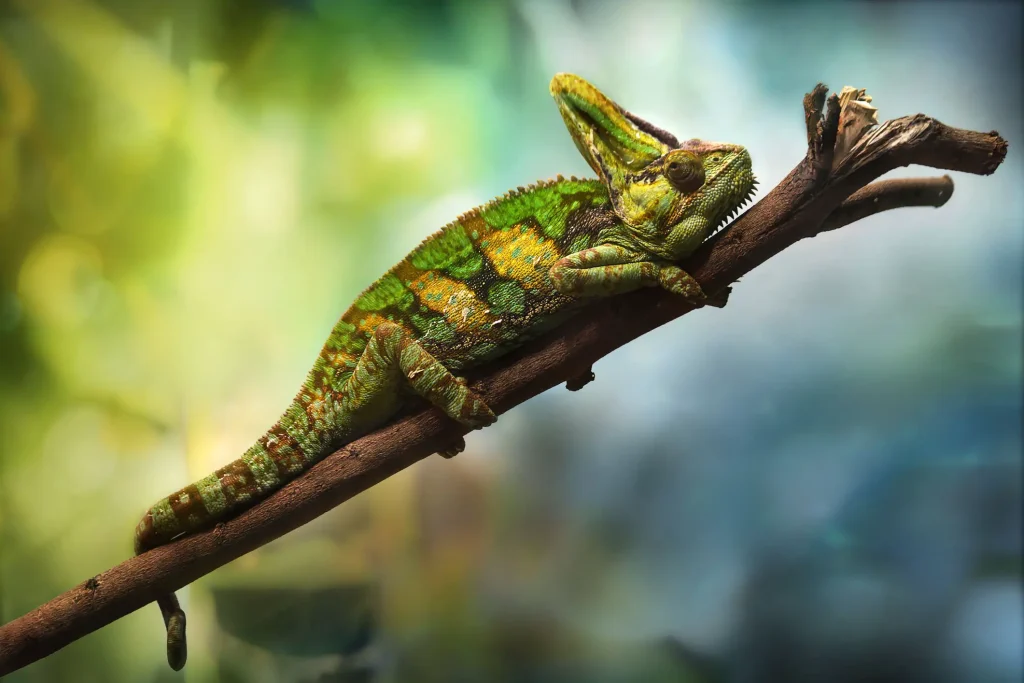Veiled chameleons are fascinating creatures that have captured the attention of reptile enthusiasts around the world. With their unique ability to change color and their striking appearance, it’s no wonder that many people are drawn to these creatures. But one question that often comes up is whether or not veiled chameleons are friendly. In this article, we’ll explore this question and take a closer look at the behavior of these intriguing reptiles.
While veiled chameleons may not be as cuddly as a kitten or a puppy, they can make great pets for those who are willing to put in the time and effort to care for them properly. However, it’s important to understand that these creatures have their own personalities and can be quite independent. So, are veiled chameleons friendly? The answer is not a simple yes or no. Like any other pet, it depends on the individual animal and their unique temperament.
Veiled chameleons are not known for being friendly. While they can tolerate occasional handling, they are primarily solitary and easily stressed, which can lead to health problems. It’s important to provide them with a suitable habitat and limit handling to avoid causing unnecessary stress.

Veiled Chameleons: Are They Friendly Pets?
Veiled chameleons are unique-looking creatures that can make for an interesting and exotic pet. However, before deciding to bring one into your home, it’s important to consider their temperament and whether they are suitable as a friendly and interactive pet. In this article, we’ll explore whether veiled chameleons are friendly and what you should know before bringing one home.
Temperament of Veiled Chameleons
Veiled chameleons are known for their striking colors and unique ability to change the color of their skin. They are also known for their territorial behavior, which can sometimes make them aggressive towards other chameleons. However, when it comes to humans, veiled chameleons can be friendly and interactive pets with the right approach.
One thing to note is that veiled chameleons are not as social as other pets, such as dogs or cats. They are more solitary creatures that may not enjoy being handled or petted like other pets. However, with patience and a gentle touch, you can still build a bond with your veiled chameleon.
How to Interact with Veiled Chameleons
If you want to interact with your veiled chameleon, it’s important to start slowly and let them get used to your presence. Spend time near their enclosure, talking to them softly and offering them treats like crickets or mealworms. Over time, they may become more comfortable with your presence and may even approach you.
When handling a veiled chameleon, it’s important to support their body and avoid gripping or squeezing them too tightly. They are delicate creatures and can be easily injured if mishandled. You should also avoid handling them for extended periods of time, as they can become stressed and agitated.
Benefits of Owning a Veiled Chameleon
While veiled chameleons may not be as social as other pets, they can still provide some unique benefits as a pet. For example, they can be fascinating to watch as they move and change colors. They also require relatively low maintenance compared to other pets and can be a good choice for people who don’t have a lot of time to devote to pet care.
Another benefit of owning a veiled chameleon is that they are relatively quiet pets. They don’t bark or meow, which can be a plus for people who live in apartments or other shared living spaces.
Vs Other Chameleons
If you’re considering a veiled chameleon as a pet, it’s important to note that there are other types of chameleons that may be more suitable for certain people. For example, panther chameleons are known for their more sociable and interactive behavior, while Jackson’s chameleons are known for being more docile and easy to handle.
It’s important to research the different types of chameleons and their temperaments before deciding which one is right for you. You should also consider factors such as size, diet, and habitat requirements before bringing a chameleon into your home.
Common Misconceptions about Veiled Chameleons
There are several common misconceptions about veiled chameleons that may make people hesitant to consider them as pets. For example, some people believe that chameleons are delicate creatures that require a lot of maintenance and special care. While it’s true that chameleons have specific habitat and dietary needs, they can still be relatively low maintenance pets.
Another misconception is that chameleons are aggressive and difficult to handle. While veiled chameleons can be territorial and may exhibit aggressive behavior towards other chameleons, they can still be friendly and interactive with humans if treated with patience and respect.
Habitat Requirements for Veiled Chameleons
If you’re considering a veiled chameleon as a pet, it’s important to understand their habitat requirements. Veiled chameleons need a large enclosure with plenty of climbing opportunities, such as branches and vines. They also require a heat lamp and UVB lighting to maintain their health.
In addition to providing a suitable habitat, you’ll also need to make sure your veiled chameleon has a proper diet. They require live insects such as crickets, mealworms, and waxworms, as well as occasional fruits and vegetables.
Common Health Issues for Veiled Chameleons
Like all pets, veiled chameleons are susceptible to certain health issues. One common issue is metabolic bone disease, which can occur if they don’t receive enough calcium or UVB lighting. Other potential health issues include respiratory infections, parasites, and injuries from falls or mishandling.
To keep your veiled chameleon healthy, it’s important to provide them with a suitable habitat, a proper diet, and regular veterinary care. You should also monitor their behavior and appearance for any signs of illness or injury.
Conclusion
Veiled chameleons can make for interesting and unique pets, but they may not be as sociable or interactive as other pets. If you’re considering a veiled chameleon as a pet, it’s important to understand their temperament and habitat requirements. With patience and a gentle touch, you can build a bond with your veiled chameleon and enjoy the benefits of owning an exotic and fascinating pet.
Frequently Asked Questions
Veiled chameleons are a popular pet due to their unique appearance and fascinating behaviors. However, many people wonder if these creatures are friendly and suitable for domestication. Here are five common questions about veiled chameleons and their temperament.
Are veiled chameleons friendly?
Veiled chameleons are not typically considered friendly pets. They are solitary creatures that prefer to be left alone and can become stressed or aggressive if handled too often or roughly. Additionally, their sharp claws and teeth can cause injury to humans.
That being said, some veiled chameleons may tolerate human interaction better than others, depending on their individual temperament and socialization. If you are interested in owning a veiled chameleon, it is important to research their care requirements and behavior thoroughly and to approach them with caution and respect.
How do veiled chameleons interact with humans?
Veiled chameleons are not social animals and do not require or seek out human interaction. They may view humans as a threat and become defensive or aggressive if approached or handled. However, some veiled chameleons may tolerate human presence or even enjoy being observed from a distance.
It is important to remember that veiled chameleons are wild animals and may not behave predictably or consistently in human environments. It is recommended to limit human interaction with veiled chameleons and to ensure that they have adequate space and resources to live comfortably in their enclosure.
Can veiled chameleons be trained?
Veiled chameleons are not capable of learning tricks or commands like dogs or other domesticated animals. They are instinct-driven creatures that rely on their natural behaviors and instincts to survive. However, some veiled chameleons can become accustomed to their owner’s presence and may recognize them as a source of food or shelter.
It is important to remember that veiled chameleons are wild animals and should be respected as such. Attempts to train or manipulate their behavior can cause stress or harm to the animal.
Do veiled chameleons like being held?
Veiled chameleons do not enjoy being held or handled. They are solitary creatures that prefer to be left alone in their enclosure. Handling can cause stress and injury to the animal, as well as increase the risk of transmitting diseases between the lizard and its owner.
If you must handle a veiled chameleon, it is important to do so with caution and respect. Avoid grabbing or squeezing the animal and support its body securely to prevent injury or escape.
How do veiled chameleons communicate?
Veiled chameleons communicate primarily through body language and coloration. They are able to change the color and pattern of their skin to blend in with their surroundings or to signal aggression or submission. They may also make hissing or grunting noises to communicate with other chameleons or to warn predators.
It is important to observe a veiled chameleon’s body language and coloration to understand its mood and behavior. Sudden changes in color or posture can indicate stress or discomfort, while relaxed or bright colors may indicate contentment or excitement.
Pros & Cons to Veiled Chameleons
In conclusion, veiled chameleons can be friendly pets if they are properly cared for and handled with care. While they may appear intimidating with their sharp claws and impressive size, they can become great companions with patience and understanding. It is important to create a comfortable and stress-free environment for your chameleon, providing them with plenty of space, appropriate lighting, and a balanced diet.
Remember, chameleons are not social creatures and may not enjoy being handled frequently. It is essential to respect their boundaries and allow them to have their alone time. With dedication and attention, you can build a strong bond with your veiled chameleon and enjoy their company for years to come.
Overall, if you are willing to put in the effort to properly care for a veiled chameleon, they can make wonderful pets. Their unique appearance and behavior make them fascinating creatures to observe, and their potential for bonding with their owners adds an extra layer of enjoyment to the experience.


